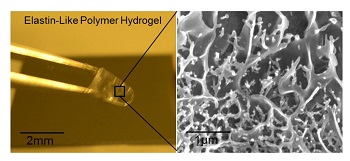Researchers at the School of Engineering and Materials Science, Queen Mary University London (QMUL), are using a Malvern Panalytical Zetasizer Nano to provide particle size and charge data that is being used in the development of innovative hydrogel matrices for 3D cell culture.
 The Zetasizer Nano is providing robust protein characterization for the development of advanced 3D cell cultures at Queen Mary University London.
The Zetasizer Nano is providing robust protein characterization for the development of advanced 3D cell cultures at Queen Mary University London.
The Zetasizer Nano’s high performance electrophoretic light scattering capabilities are allowing researchers to better understand the nature of the electrostatic interactions between proteins and peptides. These measurements are crucial to developing bespoke cell culture platforms for the production of specific biologically significant hydrogel.
By creating hydrogel structures based on the charge of target biomolecules, researchers at QMUL aim to develop a fabrication process for advanced cell cultures that accurately represents scenarios within healthy or diseased tissue.
Precise in vitro recreation of the complex biological environments is appealing for applications within drug screening, biological studies and tissue engineering. As molecular size and charge define the parameters of these experiments, robust multivariate molecular analysis forms the bedrock of our research. The Zetasizer Nano has reliably delivered a substantial portion of this data and continues to help drive our research.
Michal Lipka, PhD student from Dr Alvaro Mata’s research group.
Find more information on Dr Alvaro Mata’s research group at http://www.sems.qmul.ac.uk/staff/research/?a.mata.
The Zetasizer Nano used in this work is one of a wide range of characterization systems available in the multi-disciplinary lab at the School of Engineering and Materials Science at QMUL. Dr Krystelle Mafina, Experimental Officer in Materials Characterization, handles all training for the instrumentation and services that allows the students to work correctly on the systems. “As part of the multi-disciplinary lab at QMUL, materials and biomaterials research groups throughout the university, from engineers and chemists through to biologists and physicists, are benefiting from access to analysis using the Zetasizer Nano,” she said.
Zetasizer Nano systems incorporate combinations of a particle size analyzer, zeta potential analyzer, molecular weight analyzer, protein mobility and microrheology measurements. They measure size and microrheology using dynamic light scattering; zeta potential and electrophoretic mobility using electrophoretic light scattering; and molecular weight using static light scattering.
In addition to the Zetasizer Nano, the lab at QMUL encompasses a range of Malvern Panalytical technology, including Mastersizer 2000 laser diffraction particle sizing and NanoSight Nanoparticle Tracking Analysis (NTA). NTA is a unique particle visualization technique that enables researchers to study the behavior of particles and molecules over time. Many research groups at the university are using NTA alongside the Zetasizer Nano both to validate results and deliver greater insight into protein behavior.
Find out more about Malvern Panalytical’s analytical systems and their role in industry and academia at www.malvern.com.